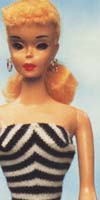
|
The Barbie Doll | ||||||
| | Contents | Search | Links | Email | |
In 1945 a new company called Mattel was formed ("Matt" for then-partner Harold Matson and "el" for Elliot Handler). It operated out of a garage making wooden doll's house furniture and plastic picture frames. The company became popular with such toys as Uke-A-Doodle and a line of boys' toy guns. Soon Harold Matson left Mattel and Elliot's wife, Ruth Handler joined the business. In 1955, while the family were on vacation in Germany, they found a doll based on a German Newspaper comic heroine. The doll was Lilli, manufactured by the German Newspaper, Bild. The doll had white irises, a pony tail and permanently arched feet, but unlike the popular baby dolls of the time, the doll had a "man's ideal" figure of a woman. Here, the story is a bit vague, with different sources claiming a different story, but what is certain is that the Number 1 Barbie looks uncannily like Bild Lilli! However, Mattel's 'Barbie,' named after Barbara Handler, Ruth and Elliot's daughter, was of a much higher quality. In 1957 Charlotte Johnston, one of the favourite designers of the 11 and a half inch wardrobe, was in Japan organising Barbie's clothes while Elliot Handler was meeting with factories organising Barbie's body! By 1958 Barbie Teen-Age Fashion Model Doll was copyrighted and ready to be unveiled at the Toy Fair in the spring in New York City. Many people criticised the doll, some even labelled her a 'tart' but Mattel continued and launched one of the cleverest and slyest advertising campaigns of all time. It was aimed directly at children through "The Mickey Mouse Club" Television show. The campaign worked and Barbie became a hit where it mattered, with the customer! The Barbie Doll went through many changes during her first five years of production as Mattel corrected apparent problems. Mattel continued and today still continues to make revisions to the doll which is one reason why the Barbie doll has always been the most popular doll in the world.
Last updated: June 01, 2003 Sixties Central, Copyright
1998-2003 by Mandy Hoeymakers. |
|
|||||
Related
Media
|
|||||||
 |
|||||||
